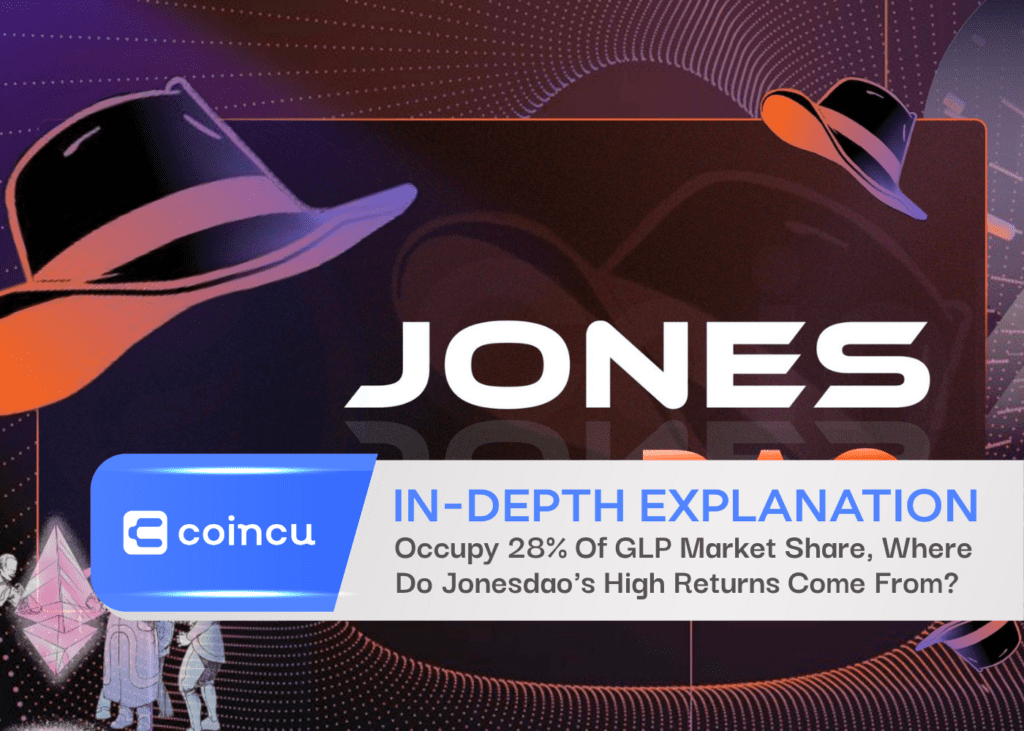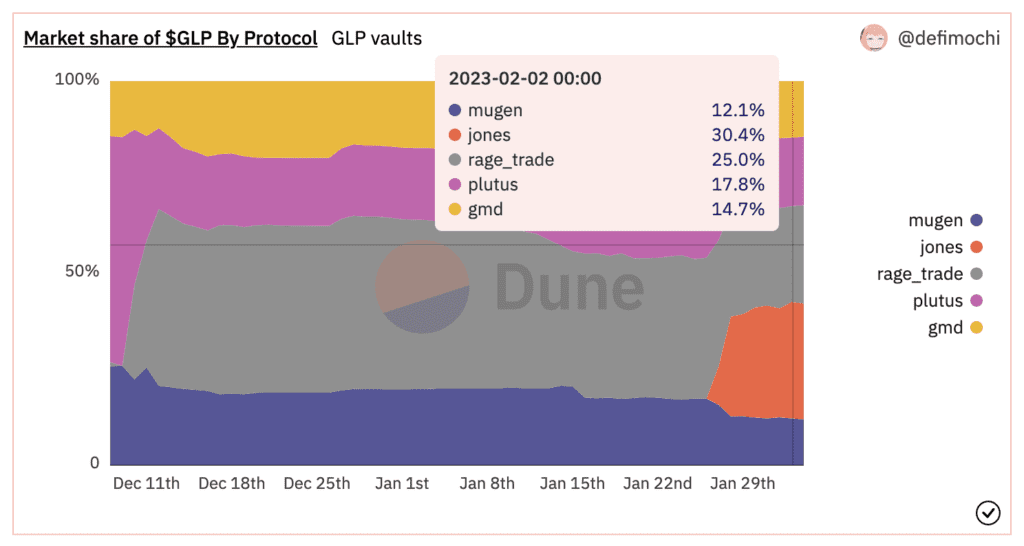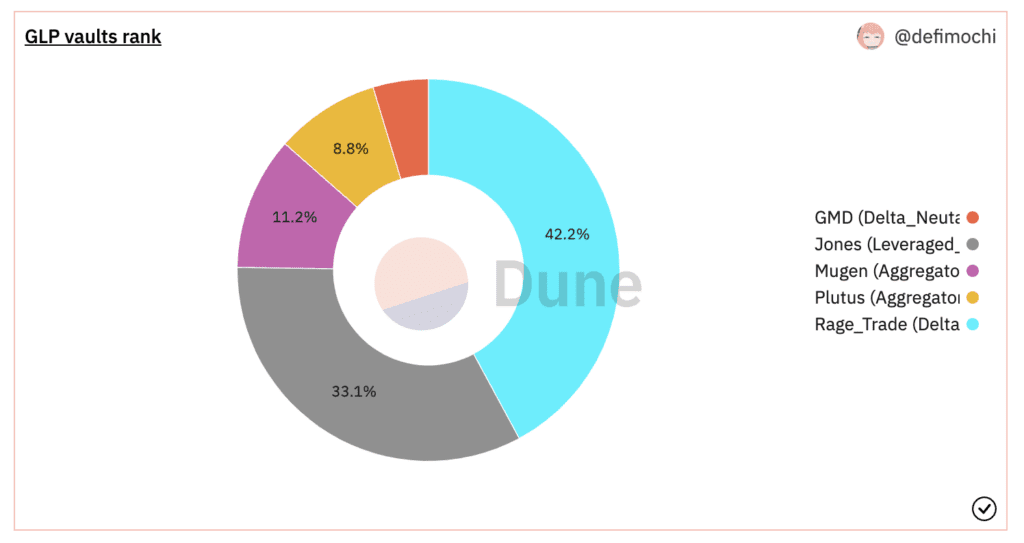Occupy 28% Of GLP Market Share, Where Do Jonesdao’s High Returns Come From?
0
0

At present, there are at least 5-10 DeFi projects on the market based on the Real Yield of GLP, and the competition for GLP is gradually enriched. Among them, the jGLP and jUSDC fund pools newly launched by the income agreement JonesDAO in January 2023 have performed well since their release.
According to the data chart released by @defimochi, jGLP has occupied more than 28% of the GLP market share in just one week, making rivals such as Mugen and Plutus all give up. What exactly is jGLP? Why can he quickly absorb a large amount of GLP? This Coincu article will explain the principles of jGLP and jUSDC pool one by one so that readers can understand the meaning of their high-yield sources.
What is JonesDAO?
JonesDAO is a DeFi revenue strategy protocol built on the Ethereum mainnet and Arbitrum.
It is mainly to build various types of fund pools, and each fund pool implements different strategies for user groups with different risk preferences. Currently, it provides three types of fund pools:
- OpFi Pools: More geared toward risk-averse investors, deposits will be used for Dopex and other Arbitrum options protocols.
- Metavaults: The deposited funds will provide various liquidity, and the fund pool will help depositors hold LP tokens.
- Advanced income strategy pool: This is more like a customized allocation pool for a new project. Currently, JoneDAO provides a combined strategy pool: jGLP + jUSDC fund pool, both of which are income strategies based on the GLP pool. We explain this part in detail below.
What are GMX and GLP?
GMX is a decentralized exchange on Arbitrum. Its featured leveraged products allow users to have a centralized trading perpetual contract-like experience. Market makers who want to become GMX need to deposit and mint GLP tokens. GLP itself is GMX’s mixed multi-asset fund pool, which provides liquidity for other trading users, and the GLP token is the equity share token of the pool.
There is a basket of assets in the GLP pool, half of which is stablecoin and half is not a stablecoin. These assets become the counterparty of all traders. GLP token holders can charge 70% of the transaction fee (issued weekly, ETH).
Can GLP be traded?
Note that although GLP is a token in ERC-20 standard, it cannot be traded or transferred in any place other than GMX because there is no conventional transfer contract (GLP contract on Arbiscan) in its contract. Nevertheless, Staked GLP can be transferred and traded like other regular ERC-20 tokens.
From the perspective of the distribution of the GLP pool, 50% of the stable currency constitutes half of the funds in the GMX market, allowing these non-stable coins to be shorted, and it also makes the “position” of LPs (GLP holders) safer, but it may It discourages LPs, because for LPs, these stablecoins are opportunity costs, and they could have easily found higher returns with these assets in a bull market.
Quantumzebra wrote an excellent analysis of what happens to GMX in a bull market, and as he states, half the pool of stablecoins is useless if no one is shorting them. Traders will only lend BTC and ETH from the GLP pool for long bets.
In order to retain LPs, Jones DAO created the jGLP + jUSDC fund pool. They used a creative “off-market” allocation mechanism to increase the incentives of GLP holders after adding leverage and, at the same time, provide low-risk income products to USDC holders.
The income principle of jGLP and jUSDC pool
The jGLP pool mints more GLP by borrowing USDC from the jUSDC pool (so that it is leveraged and earns more ETH fees), and takes most of the new income, thereby increasing the income of GLP.
Users deposit GLP or any token in the GLP basket (UNI, LINK, ETH, WBTC) into the jGLP vault. (All baskets of tokens are first mortgaged into GLP in GMX by the smart contract of jGLP vault).
Users can withdraw GLP or any GLP component token (UNI, ETH, LINK, etc.) from the jGLP pool at any time, and the treasury will help users redeem it from GMX, but users need to pay the corresponding fees.
- The jGLP pool will mint jGLP note tokens to stakers (only if they have opted for auto-compounding)
- The GMX fee income generated by these GLPs deposited will be fully transferred to jGLP holders. Up to this point, there is no difference in the rewards for holding GLP versus depositing it in a jGLP vault.
- So where does the extra income come from? Because the smart contract of the jGLP fund pool will borrow $USDC from (and only from) the jUSDC vault, which is used to mint more GLP to achieve increased leverage positions.
How many dollars will jGLP borrow to leverage? How much leverage is there? Will the leverage ratio change?
At present, we cannot find relevant data to show the exact leverage ratio, but JonesDAO stated that its capital pool adopts a dynamic leverage ratio, which is opposite to the market trend. When the market goes down, it goes up, and vice versa.
According to its official document, it only states that it borrows USDC within specific risk parameters and anchors the target leverage range.
- Therefore, the GLP in the jGLP pool can be divided into two parts: the basic part (direct deposit from jGLP holders) + the leverage part (GLP of mint borrowed from the jUSDC fund pool).
- The proceeds from the leveraged portion (also GMX fees) will be distributed to three parties: jGLP holders, jUSDC holders (30%-50%), and the governance library.
The jUSDC pool is the source of liquidity for jGLP leverage. Suitable for users with low-risk appetites. The stablecoin lending income of this pool is higher than that of ordinary reception protocols such as AAVE and Compound.
- Users deposit USDC into the jUSDC pool to earn interest. The rate of return is, of course, lower than GLP, but at least it is more profitable than other lending agreements.
- The jUSDC pool will mint jUSDC note tokens to stakers only if they choose to auto-compound.
Note that you need to initiate an application in advance to withdraw coins from the jUSDC pool, and the withdrawal can be opened after 24 hours.
- The deposited USDC will be directly lent by the jGLP contract with a “specific leverage ratio” set to mint more GLP in GMX to achieve leverage (earn more fees).
- These newly minted GLP will generate more GMX fee income. These gains are distributed according to the leverage section rules we mentioned earlier. jUSDC holders can earn 30% to 50% of the leverage portion of the return, depending on the utilization of the jUSC pool.
Three sources of income make up jGLP’s high yield
jGLP holders mainly benefit from three aspects:
- Base part. The GLP directly deposited by users will continuously receive GMX’s handling fee (ETH issued every week), all of which will be distributed to jGLP holders (original yield
 ).
). - Leverage part. The $USDC borrowed from the jUSDC pool is also minted into GLP, and the ETH sent by GMX is received every week, and a large part of it is given to jGLP holders. (more yield
 )
) - Reflexive incentives without withdrawal. An incentive to prevent withdrawal of liquidity comes from users who withdraw withdrawals from the jGLP pool and distribute them to LPs who remain in the pool.
Additional sources of incentives: automatic compounding rewards and withdrawal penalties
Withdrawals from jGLP are subject to a 3% fee on the total position. 1/3 of this will be distributed to other depositors as a no-withdrawal bonus. 2/3 will be distributed to users (holders of jGLP receipt tokens) who have opted for automatic compounding.
Users of jUSDC will mainly benefit from the rate of return on the leveraged part. Withdraw from jUSDC, you also need to pay other jUSDC users 0.97% of their position size as a retained “non-withdrawal reward.”
However, the actual rewards received by the remaining jUSDC stakers are different from 0.97%. Real is the difference between the above amount (0.97%) and the actual cost of GMX redeeming USDC. When the cost is higher than the 0.97% fee, there will be no retention rewards.
Please note that when withdrawing USDC from the jUSDC fund pool, the first source of liquidity is the unused idle USDC in the pool. Withdrawals in excess will require the burning of the GLP implementation in GMX.
Conclusion
Please note that jGLP + jUSDC does not eliminate any opportunity cost or counterparty risk of GLP; on the contrary, it just increases the rate of return of directly holding GLP by means of leverage, making it more attractive, and This is achieved by borrowing money from other risk-averse users.
This pattern serves two types of users:
- GLP holders may want to increase the risk premium for various reasons (really many risks, index fluctuations, counterparties, etc.). In this way, JonesDAO can earn more GLP by offering attractive yields.
- And there must be risk-averse users who are not satisfied with the interest of the loan agreement and want higher returns. Jones DAO also provides relatively high-yield products for risk-averse users.
But for the latter (coin depositors of jUSDC), they actually bear the liquidity risk of GLP indirectly because their own money was also used for mint GLP, but they did not get the 100% return due to the risk (most of it was forked by jGLP) but only a part.
If there is a real USDC redemption run on GMX, jUSDC pool users will be greatly affected. As for whether the additional risk premium can cover these new risks, we still lack data support. Leverage ratio data and detailed fee structure are lacking in official documents and white papers. Therefore, DYOR should be cautious when making any decisions, and we will continue to follow up.
DISCLAIMER: The Information on this website is provided as general market commentary and does not constitute investment advice. We encourage you to do your own research before investing.
Join us to keep track of news: https://linktr.ee/coincu
Harold
Coincu News
0
0
 Manage all your crypto, NFT and DeFi from one place
Manage all your crypto, NFT and DeFi from one placeSecurely connect the portfolio you’re using to start.










